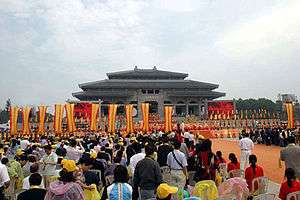Shennong
Shennong (神農, Shénnóng, which can be variously translated as "Divine Farmer" or "Divine Peasant", "Agriculture God"), also known as the Wugushen (五穀神 "Five Grains' or Five Cereals' God"), Wuguxiandi (五穀先帝 "First Deity of the Five Grains"), and Thần Nông, is a mythological Chinese and Vietnamese deity in Chinese and Vietnamese folk religion and venerated as a mythical sage ruler of prehistoric China and Vietnam.
| Shennong | |||||||||
|---|---|---|---|---|---|---|---|---|---|
.jpg) Shennong as depicted in a 1503 painting by Guo Xu | |||||||||
| Chinese name | |||||||||
| Traditional Chinese | 神農 | ||||||||
| Simplified Chinese | 神农 | ||||||||
| Literal meaning | Divine Farmer, Divine Peasant | ||||||||
| |||||||||
| Five Cereals' God, Five Grains' First Deity | |||||||||
| Chinese | 五谷神 / 五谷先帝 | ||||||||
| |||||||||
| Vietnamese name | |||||||||
| Vietnamese | Thần Nông | ||||||||
| Hán-Nôm | 神農 | ||||||||
| Korean name | |||||||||
| Hangul | 신농 | ||||||||
| Hanja | 神農 | ||||||||
| |||||||||
| Japanese name | |||||||||
| Kanji | 神農 | ||||||||
| |||||||||
Shennong has at times been counted amongst the Three Sovereigns (also known as "Three Kings" or "Three Patrons"), a group of ancient deities or deified kings. Shennong has been thought to have taught the ancient Chinese not only their practices of agriculture, but also the use of herbal drugs.[1] Shennong was credited with various inventions: these include the hoe, plow (both leisi style and the plowshare), axe, digging wells, agricultural irrigation, preserving stored seeds by using boiled horse urine, the weekly farmers market, the Chinese calendar (especially the division into the 24 jieqi or solar terms), and to have refined the therapeutic understanding of taking pulse measurements, acupuncture, and moxibustion, and to have instituted the harvest thanksgiving ceremony (Zhaji Sacrificial Rite, later known as the Laji Rite).[2]
"Shennong" can also be taken to refer to his people, the Shennong-shi (Chinese: 神農氏; pinyin: Shénnóngshì; lit.: 'Shennong Clan').
Mythology

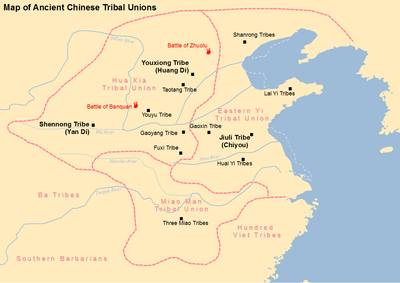
In Chinese mythology Shennong taught humans the use of the plow together with other aspects of basic agriculture, the use of medicinal plants, and was a god of the burning wind (perhaps in some relationship to the Yan Emperor mythos and/or slash-and-burn agriculture,[3] in which the ash produced by fire fertilizes the fields). He was also sometimes said to be a progenitor to, or to have had appointed as one of his ministers, Chiyou (and like him, was ox-headed, sharp-horned, bronze-foreheaded, and iron-skulled).[3] One difference between mythology and science is exemplified in Chinese mythology. Shennong is also thought to be the father of Huang Emperor (黃帝) who did carry on the secrets of medicine, immortality, and making gold.[4] According to the eighth century AD historian Sima Zhen's commentary to the second century BC Shiji (or, Records of the Grand Historian), Shennong is a kinsman of the Yellow Emperor and is said to be an ancestor, or a patriarch, of the ancient forebears of the Chinese.
Popular religion
According to some versions of the myths about Shennong, he eventually died as a result of his researches into the properties of plants by experimenting upon his own body, after, in one of his tests, he ate the yellow flower of a weed that caused his intestines to rupture before he had time to swallow his antidotal tea: having thus given his life for humanity, he has since received special honor though his worship as the Medicine King (藥王 Yàowáng).[5] The sacrifice of cows or oxen to Shennong in his various manifestations is never at all appropriate; instead pigs and sheep are acceptable. Fireworks and incense may also be used, especially at the appearance of his statue on his birthday, lunar April 26, according to popular tradition. Under his various names, Shennong is the patron deity especially of farmers, rice traders, and practitioners of traditional Chinese medicine. Many temples and other places dedicated to his commemoration exist.[6]
Historicity
Reliable information on the history of China before the 13th century BC can only come from archaeological evidence, because China's first established written system on a durable medium, the oracle bone script, did not exist until then.[7] Thus the concrete existence of even the Xia dynasty - said to be the successor to Shennong - is yet to be proven, despite efforts by Chinese archaeologists to link that dynasty with Bronze Age Erlitou archaeological sites.[8]
However, Shennong, both the individual and the clan, are very important, in the history of culture—especially in regards to mythology and popular culture. Indeed, Shennong figures extensively in historical literature.
Shennong in literature
Sima Qian (司馬遷) mentions that the rulers directly preceding the Yellow Emperor were of the house (or societal group) of Shennong (神農).[9] Sima Zhen, who added a prologue for the Records of the Grand Historian (史記), said his surname was Jiang (姜), and proceeded to list his successors. An older and more famous reference is in the Huainanzi; it tells how, prior to Shennong, people were sickly, wanting, starved and diseased; but he then taught them agriculture, which he himself had researched, eating hundreds of plants — and even consuming seventy poisons in one day.[10] Shennong also features in the book popularly known in English as I Ching. Here, he is referenced as coming to power after the end of the house (or reign) of Paoxi (Fu Xi), also inventing a bent-wood plow, a cut-wood rake, teaching these skills to others, and establishing a noonday market.[11] Another reference is in the Lüshi Chunqiu, mentioning some violence with regard to the rise of the Shennong house, and that their power lasted seventeen generations.[12][13]
The Shénnóng Běn Cǎo Jīng is a book on agriculture and medicinal plants, attributed to Shennong. Research suggests that it is a compilation of oral traditions, written between about 200 and 250 AD.[14]
Popular culture
As noted above, Shennong is said in the Huainanzi to have tasted hundreds of herbs to test their medical value. The most well-known work attributed to Shennong is The Divine Farmer's Herb-Root Classic (simplified Chinese: 神农本草经; traditional Chinese: 神農本草經; pinyin: Shénnóng Běncǎo Jīng; Wade–Giles: Shen2-nung2 Pen3-ts'ao3 Ching1), first compiled some time during the end of the Western Han Dynasty — several thousand years after Shennong might have existed. This work lists the various medicinal herbs, such as lingzhi, that were discovered by Shennong and given grade and rarity ratings. It is considered to be the earliest Chinese pharmacopoeia, and includes 365 medicines derived from minerals, plants, and animals. Shennong is credited with identifying hundreds of medical (and poisonous) herbs by personally testing their properties, which was crucial to the development of traditional Chinese medicine. Legend holds that Shennong had a transparent body, and thus could see the effects of different plants and herbs on himself. Tea, which acts as an antidote against the poisonous effects of some seventy herbs, is also said to have been his discovery. Shennong first tasted it, traditionally in ca. 2437 BC, from tea leaves on burning tea twigs, after they were carried up from the fire by the hot air, landing in his cauldron of boiling water.[15] Shennong is venerated as the Father of Chinese medicine. He is also believed to have introduced the technique of acupuncture.
Shennong is said to have played a part in the creation of the guqin, together with Fuxi and the Yellow Emperor. Scholarly works mention that the paternal family of famous Song dynasty General Yue Fei traced their origins back to Shennong.[16]
Places
Shennong is associated with certain geographic localities including Shennongjia, in Hubei, where the rattan ladder which he used to climb the local mountain range is supposed to have transformed into a vast forest. The Shennong Stream flows from here into the Yangtze River.
Gallery
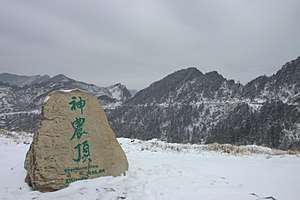 Shennongding: "Shennong's peak", associated with the story that Shennong had a ladder which he used to climb up and down the mountain, and which later turned into the local forest.
Shennongding: "Shennong's peak", associated with the story that Shennong had a ladder which he used to climb up and down the mountain, and which later turned into the local forest.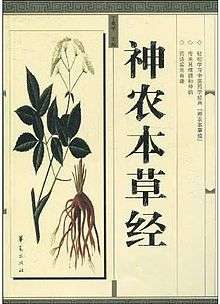 A picture of Shennong bencao jing (Shennong's Root and Herbal Classic): a classic work on plants and their uses, named in attribution to Shennong.
A picture of Shennong bencao jing (Shennong's Root and Herbal Classic): a classic work on plants and their uses, named in attribution to Shennong.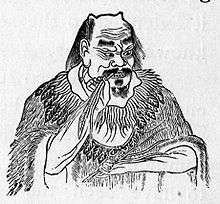 Shennong tasting plants to test their qualities on himself.
Shennong tasting plants to test their qualities on himself.- The Shennongxi Bridge near its confluence with the Yangtze River.
- Shennong Temple in Taiwan — where he is worshiped under the names King Yan, God of Five Grains, Shennong the Great Emperor, the Ancestor of Farming, Great Emperor of Medicine, God of Earth, and God of Fields.[17]
_derivative.jpg)
 Shennong as depicted by Gan Bozong, woodcut print, Tang dynasty (618-907)
Shennong as depicted by Gan Bozong, woodcut print, Tang dynasty (618-907)
See also
| Wikimedia Commons has media related to Shennong. |
Notes
- Christie 1975, p. 87.
- Yang, An & Turner 2005, pp. 190-199.
- Christie 1975, p. 90.
- Christie 1975, pp. 116-117.
- Yang, An & Turner 2005, p. 195.
- Yang, An & Turner 2005, pp. 198-199.
- Bagley, Robert (1999). "Shang Archaeology". In Loewe, Michael; Shaughnessy, Edward (eds.). The Cambridge History of Ancient China. Cambridge: Cambridge University Press.
- Liu, L.; Xiu, H. (2007). "Rethinking Erlitou: legend, history and Chinese archaeology". Antiquity. 81 (314): 886–901.
- Wu (1981, p. 53), referring to Shiji, Chapter One.
- Wu (1981, p. 45), referencing Huainanzi, xiuwu xun
- Wu (1981, p. 54), referencing I Ching, xici, II, chapter 2
- Wu (1981, p. 54), lisulan, 4, yongmin.
- Christie 1975, p. 141.
- Unschuld 1986, p. 17.
- Jane Reynolds; Phil Gates; Gaden Robinson (1994). 365 Days of Nature and Discovery. New York: Harry N. Adams. p. 44. ISBN 0-8109-3876-6.
- Kaplan, Edward Harold (1970). Yueh Fei and the founding of the Southern Sung (PhD Thesis). University of Iowa. OCLC 63868015.
- Yang, An & Turner 2005, p. 199.
References
- Christie, Anthony (1975). Chinese Mythology. London: Hamlyn. ISBN 0600006379.CS1 maint: ref=harv (link)
- Forbes, Andrew; Henley, David (2011). China's Ancient Tea Horse Road. Congoscenti.CS1 maint: ref=harv (link)
- Wu, K. C. (1981). The Chinese Heritage. New York: Crown. ISBN 051754475X.CS1 maint: ref=harv (link)
- Unschuld, Paul U. (1986). Medicine in China: A history of Pharmaceutics. Berkeley: University of California Press. ISBN 9780520050259.CS1 maint: ref=harv (link)
- Yang, Lihui; An, Deming; Turner, Jessica Anderson (2005). Handbook of Chinese mythology. Oxford: Oxford University Press. ISBN 9780195332636.CS1 maint: ref=harv (link)
External links
- Statue of Shennong in ZhuZhou
- Variants on the nóng character.
- "Shen Nong and Tea" article from The Tea Site.
Shennong | ||
| Regnal titles | ||
|---|---|---|
| Preceded by Fuxi |
Emperor of China c. 2737 BC – c. 2698 BC |
Succeeded by Yellow Emperor |
